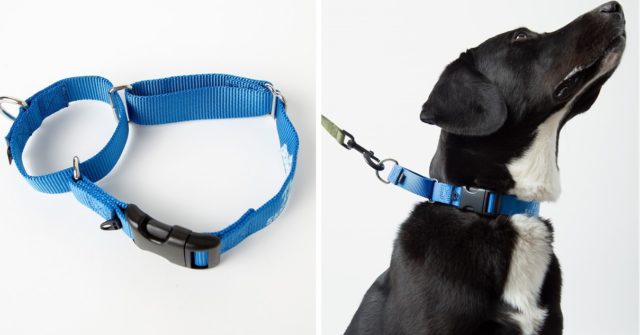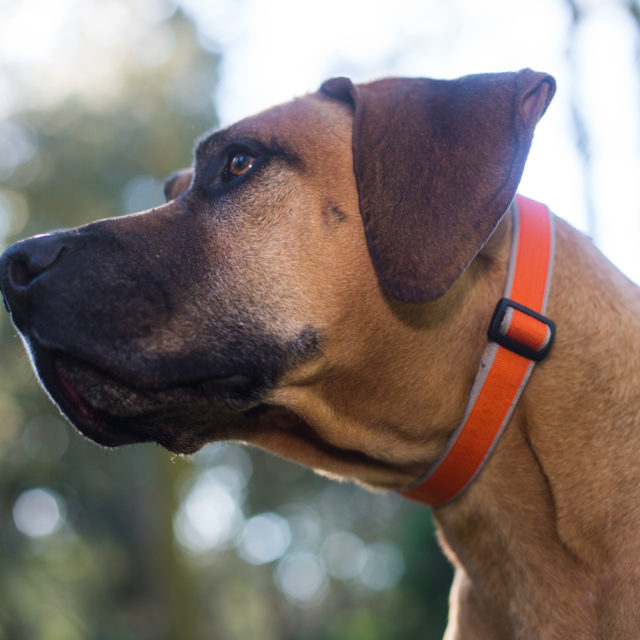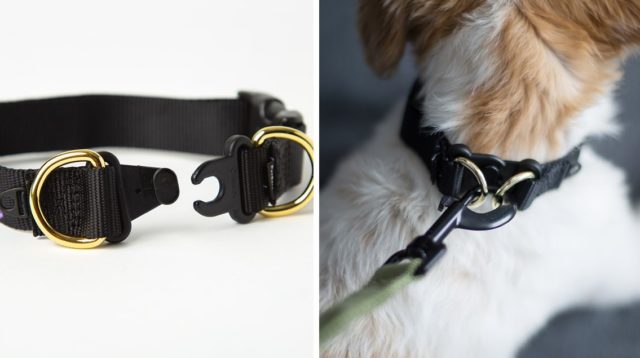Did you know that more than 26,000 collar-related accidents occur every year? Sadly, many of these incidents prove fatal. We’ve rounded up the best and worst dog collars and rated them to help you find the safest option for your pup.
The collar you choose could mean the difference between life and death.
Traditional Collars
Traditional collars consist of an adjustable strip of fabric or leather with a buckle or clasp closure.
The Good
These collars are perfect for holding your dog’s identification tags and showing off your unique style with a wide variety of colors, patterns, and materials.
Some have reflective safety strips or are made from recycled materials. Others have bows or flower appliques to up the cuteness factor. You can even find matching bracelet and collar sets so you and your pooch can be totally simpatico!

The Bad
While these collars are resizable, they must be adjusted by hand. Unfortunately, some dog parents neglect to resize the collar as their pup grows, resulting in serious injuries to the neck. In extreme cases, surgery has been required to remove collars from dogs’ flesh.
On the other hand, if the collar is too loose it can slip off, resulting in a lost or endangered dog. Traditional collars can also become snagged on something causing the dog to panic. The more they struggle, the more the collar twists and tightens. Without intervention, this can quickly become a life-threatening choking incident.
iHeartDogs Rating: ♥♥♥

Slip Collars
Also known as choke collars, these metal chain collars help train dogs not to pull on the leash.
The Good
Unfortunately, there isn’t much good to be said about these collars. Since they tighten when the dog pulls, there is little chance of them slipping off during a walk.

The Bad
Some people choose choke collars to encourage their dogs to walk politely on a leash. Whether the dog pulls on the lead or the owner delivers a corrective tug, these collars can potentially damage the neck and spine. Chain slip collars also pose a strangulation hazard and should never be left on the dog when not in use.
“There is no way to control how much the choke chain tightens, so it’s possible to choke or strangle your dog. It can also cause other problems, too, such as injuries to the trachea and esophagus, injuries to blood vessels in the eyes, neck sprains, nerve damage, fainting, transient paralysis and even death.” — HumaneSociety.org
For these reasons, veterinarians and dog trainers now favor training harnesses that distribute pressure across the chest rather than the neck. If you do choose to buy a choke chain, use caution and remove it after walks or training sessions.
iHeartDogs Rating: ♥
Prong or Pinch Collars
The inner length of a prong or pinch collar consists of metal spikes with blunt tips. The area that the leash attaches to is known as a control loop. It helps prevent the collar from tightening too much and injuring the neck.

The Good
Despite their cruel appearance, prong collars can be effective training tools when used properly. Unlike slip collars, the amount of pressure applied to the neck can be controlled, minimizing the risk of injury.
The Bad
Like chain slip collars, metal prong collars must be used with caution and removed when not in use. Training harnesses are still the preferred choice, but if you intend to use a prong collar, be sure you size, fit, and use it correctly!
iHeartDogs Rating: ♥♥
Breakaway Collars
Breakaway or quick-release dog collars look similar to traditional collars. They consist of a specialized clasp designed to release under pressure. The dual leash loops help you maintain control over your dog even if the clasp releases on a walk.
The Good
Breakaway collars are a dog parent’s best friend in an emergency. Should your dog’s collar become caught on anything, the pressure will cause the clasp to release, preventing neck injuries and choking.
Since breakaway collars are similar to traditional collars, you can find them in fun colors and even have them customized!
The Bad
If the collar is not secured by both D-rings it may become lost when the quick-release mechanism is engaged. However, a lost collar is a small price to pay for the life of your dog!
iHeartDogs Rating: ♥♥♥♥
Martingale Collars
Also known as limited slip collars, Martingale collars have an additional loop of material attached to the main collar by two rings. When the dog pulls, the collar tightens, but only to the limited degree allowed by the safety loop. These collars are often used in Greyhounds and other breeds with narrow heads.

The Good
Martingale collars safely prevent dogs from slipping out of their collars while walking on a leash. When the dog is not pulling against the leash, the collar fits loosely and comfortably.
The Bad
Martingale collars may not be the best option for thick-necked dogs or very small pups. Like all collars, you should remove your dog’s martingale collar when not in use to prevent accidents.
iHeartDogs Rating: ♥♥♥♥
Whichever collar you choose, be sure it fits properly as your pup grows. You should be able to place all four fingers of one hand comfortably between the collar and the dog’s neck. If it is too tight it can cause skin irritation or even become embedded in the neck. If it is too loose it may slip over your dog’s head on walks.


 Toledo, United States.
Toledo, United States.